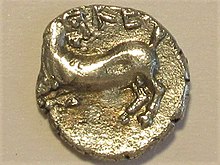Kelenderis
Coordinates: 36 ° 9 ′ N , 33 ° 19 ′ E

Kelenderis ( Greek Κελενδερίς , Latin : Celenderis ) was an ancient city in Rough Cilicia in what is now southern Turkey. It was in the area of today's district town Aydıncık (formerly Gilindere) in the province of Mersin .
history
According to the excavator Levent Zoroğlu, Kelenderis belonged to the Pirindu region with the capital Kiršu , which is mentioned in a Babylonian text concerning a campaign in Rough Cilicia. Pomponius Mela describes the founding of the city by Ionic settlers from Samos . This is also supported by vases of the Eastern Greek type that were found during excavations in Kelenderis. In the library of Apollodorus, on the other hand, it is reported that it was founded by Sandokos , who was identified with the Luwian god Šanta , which suggests a considerably earlier settlement by Luwians, in the 2nd millennium BC. Chr., Would suggest. Since Sandokos is said to have come from Syria according to this report , there is also the possibility of a Phoenician foundation. However, no archaeological findings confirm these theories.
In the 5th century BC, the city was a member of the Attisch-Delischen Seebunds . The importance of the place lay in its port, which was on important west-east sea routes and also offered the shortest connection from the mainland of Asia Minor to Cyprus . In Roman times the port became too small and lost in importance. Nevertheless, the place was continuously inhabited in Byzantine times and up to the present day. In Byzantine times Kelenderis was a bishopric, from which the titular bishopric of Celenderis goes back.
ruins
Due to the fact that Kelenderis has been continuously settled to this day, few relics can be found, as they were always built over by the respective successor residents. At the harbor there are remains of thermal baths , there is also a large but severely disturbed necropolis, an unexcavated theater and remains of cisterns and fortification walls. All the visible ruins are from Roman or later times.
Research history
Because of the city's location on busy sea routes, numerous European travelers have visited and described the place since the 18th century. These include the English amateur archaeologist William Martin Leake , the British captain Francis Beaufort , who drew a map of the ruins, later the French traveler and orientalist Victor Langlois and Louis Duchesne , who was the first to collect the inscriptions. In the 20th century, Freya Madeline Stark visited Kelenderis , among others, and in 1986 Levent Zoroğlu from the Selçuk University in Konya began excavations in collaboration with the Anamur Museum. The finds from the excavations are exhibited in Anamur and in the Karaman Museum.
literature
- Gernot Lang: Classical Ancient Sites of Anatolia . Books on Demand 2003, ISBN 3-8330-0068-6 , pp. 541-544 ( limited preview in Google Book Search).
- George Long: Celenderis . In: William Smith : Dictionary of Greek and Roman Geography. London 1854.
- Terence Bruce Mitford #: Kelenderis, later Gilindire (Aydincik) Rough Cilicia, Turkey . In: Richard Stillwell et al. a. (Ed.): The Princeton Encyclopedia of Classical Sites. Princeton University Press, Princeton NJ 1976, ISBN 0-691-03542-3 .
Web links
- Levent Zoroğlu: Kelenderis, A Port between Asia Minor and Cyprus ( Memento from July 21, 2011 in the Internet Archive )
- Coins from Kelenderis (English)
Individual evidence
- ^ Pomponius Mela: De Chorographia 1, 68 .
- ^ Gods and heroes of the Greeks: The library of Apollodorus, English translation by Michael Simpson. Univ. of Massachusetts Press, 1976, ISBN 0-87023-206-1 , p. 202 ( limited preview in Google Book Search).


